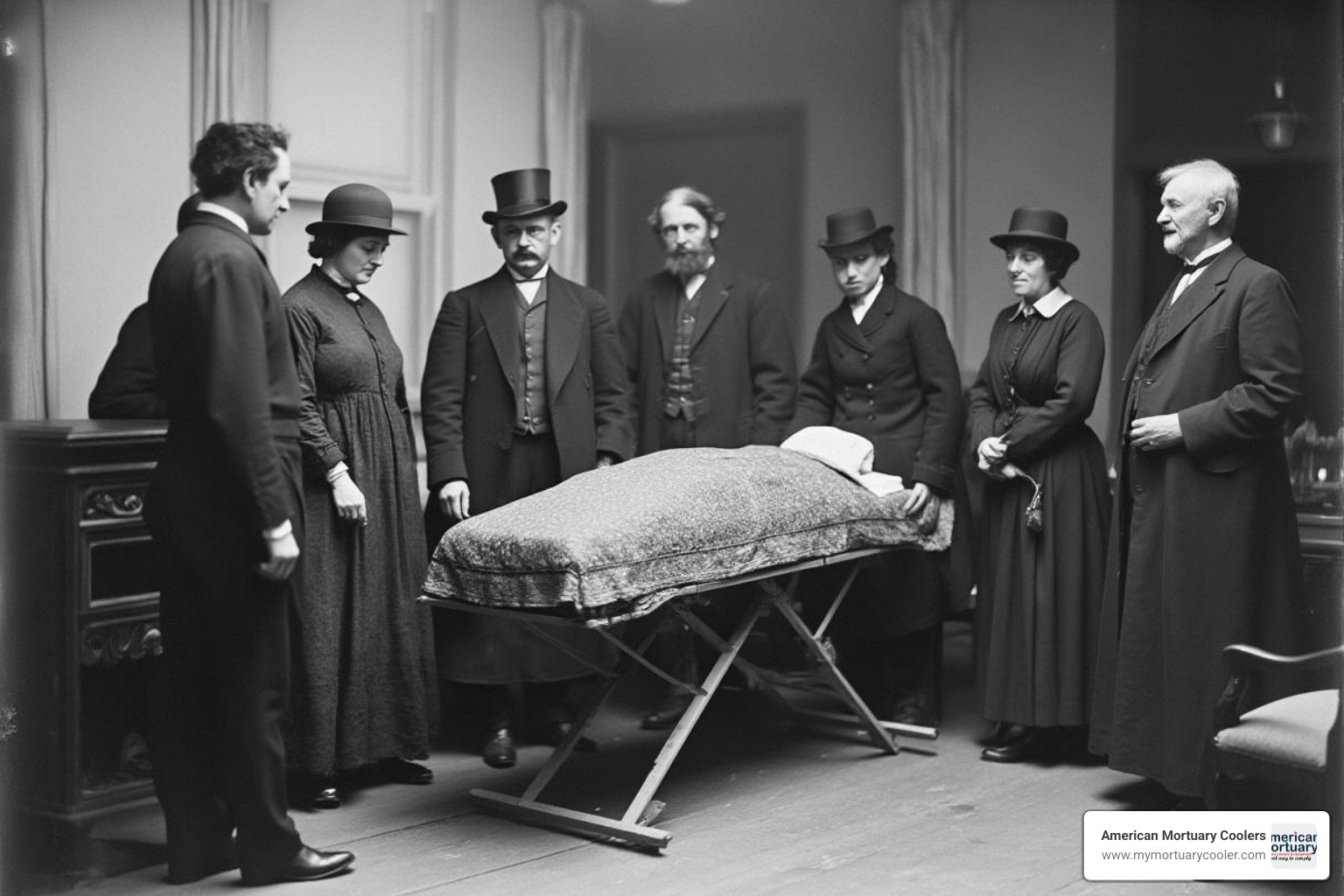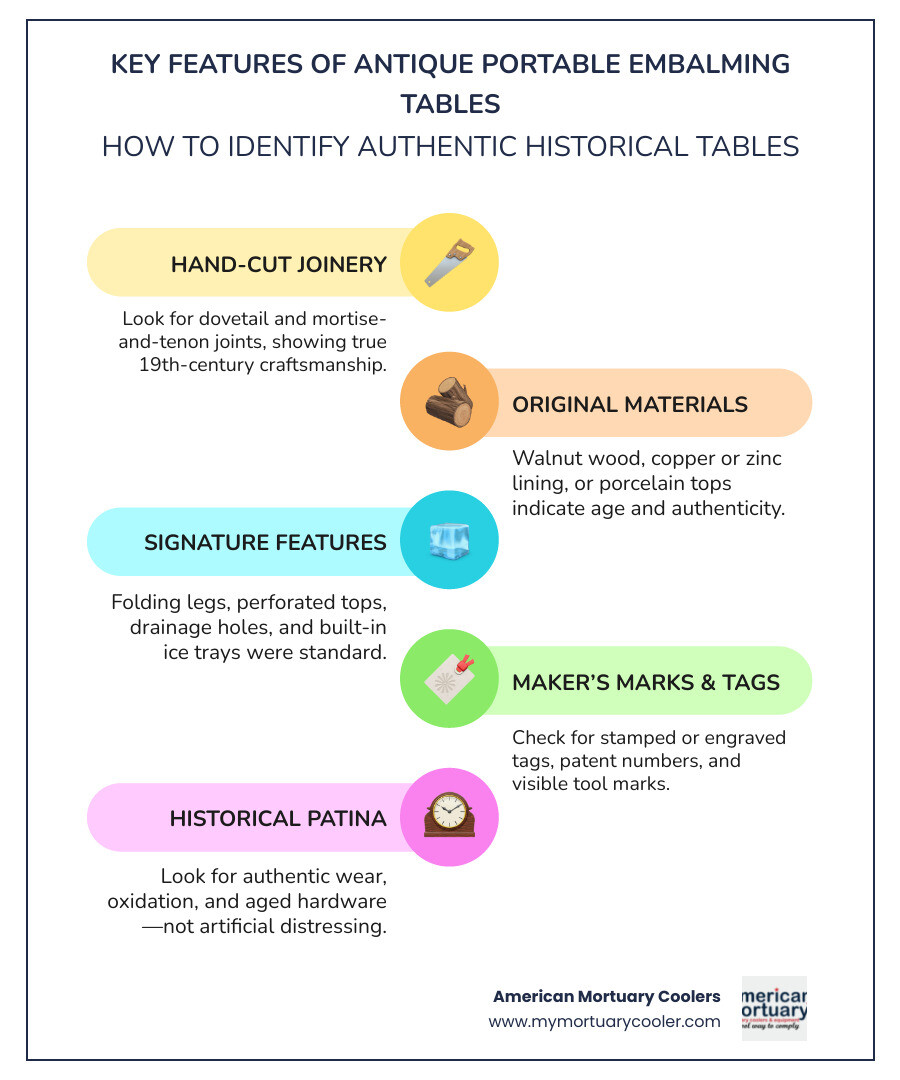Why Antique Portable Embalming Tables Transformed American Funeral Practices
Antique portable embalming table designs revolutionized mortuary services in the 1800s, allowing undertakers to bring professional embalming directly to grieving families' homes. These ingenious folding tables weighed under 30 pounds yet could extend to accommodate adult bodies, featuring copper-lined surfaces and drainage systems that made field embalming possible during the Civil War era.
Key Facts About Antique Portable Embalming Tables:
- Weight: Typically under 30 pounds when folded
- Dimensions: Folded to 38" x 19" x 4.5", extended to 75" long
- Materials: Walnut frames with copper or zinc linings
- Era: Peak use from 1861-1930s
- Price Range: $1,200-$7,500 in today's market
- Notable Makers: B.F. Gleason, George Tiemann, Royal Doulton
The Civil War marked a turning point when Dr. Thomas Holmes personally embalmed over 4,000 soldiers using portable equipment. These tables featured hinged legs that folded inside the frame, steel carrying handles, and perforated tops that allowed cold air from ice blocks to preserve bodies during multi-day funeral preparations.
From battlefield improvisations using doors laid across barrels to sophisticated patented designs like George P. Gaston's 1885 adjustable embalming table, these portable units reflect both American ingenuity and changing attitudes toward death and mourning.
I'm Mortuary Cooler, a national-level mortuary equipment supplier with experience in both modern and historical embalming table design. Having worked with funeral homes across America, I've seen how understanding the evolution of antique portable embalming table innovations helps directors appreciate the craftsmanship and functionality that shapes today's mortuary equipment standards.
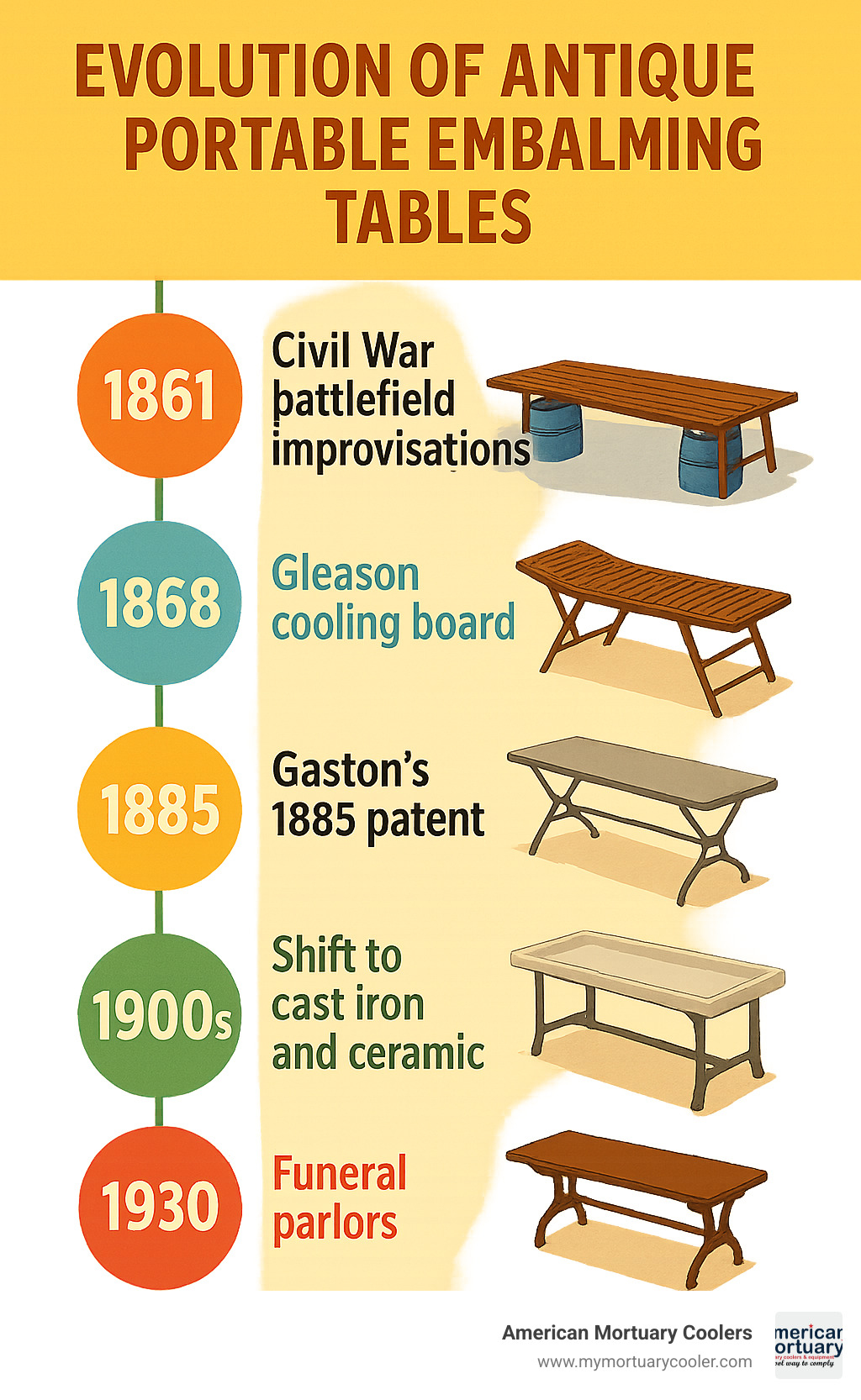
Handy antique portable embalming table terms:
What Is an Antique Portable Embalming Table?
Picture this: It's 1865, and a family has lost their beloved father. Instead of loading him onto a wagon for transport to a distant funeral parlor, the local undertaker arrives at their front door with a compact wooden case. Within minutes, he's unfolded a professional antique portable embalming table right in their parlor, ready to provide dignified preparation services in the comfort of home.
An antique portable embalming table was essentially a collapsible workshop designed for preparing and preserving the deceased between the Civil War era and the early 1900s. These weren't the massive, stationary tables we see in modern funeral homes—they were lightweight marvels of Victorian engineering.
The genius lay in their portability. Most antique portable embalming tables weighed less than 30 pounds when folded, yet could support a full-grown adult when extended. The secret was in the design: hinged legs that collapsed neatly inside the frame, copper or zinc lining that resisted corrosion from embalming chemicals, and strategic drainage holes that allowed fluids to flow away safely.
When unfolded, these tables typically measured around 75 inches long—plenty of room for most adults. Folded up, they compressed to roughly 38" x 19" x 4.5", about the size of a large suitcase. Many featured a steel carrying handle that made transport manageable, even up narrow Victorian staircases.
The most sophisticated models included an ice-cooling tray beneath the main surface. Before refrigeration became common, undertakers relied on ice blocks to slow decomposition during multi-day funeral preparations. Cold air would rise through the perforated top, creating a makeshift cooling system that kept bodies preserved while families gathered from distant locations.
Keyword Origins: Why "antique portable embalming table" Matters Today
Search intent typically falls into three categories: serious collectors seeking authenticated pieces for historical preservation, interior designers hunting for statement furniture with gothic flair, and history enthusiasts researching Victorian funeral practices. The macabre décor trend has particularly boosted interest, with these tables finding new life as unique kitchen islands, bar tops, or display pieces in themed restaurants.
Anatomy of the Antique Portable Embalming Table
The hinged legs were the star feature—usually made from sturdy hardwood like walnut, they folded inward with precision-cut joints that locked securely when extended. The perforated top wasn't just functional; it was often beautifully crafted with hand-drilled holes in geometric patterns.
This surface was typically lined with copper or zinc sheeting that could withstand harsh chemicals while remaining easy to clean. That steel carrying handle was carefully positioned to balance the folded table's weight distribution. The ice-cooling tray appeared in more expensive models, usually as a sliding drawer positioned to maximize airflow.

19th- & Early 20th-Century Evolution of Portable Tables
The antique portable embalming table evolved through decades of necessity, innovation, and changing American attitudes toward death. What started as battlefield improvisation during the Civil War gradually transformed into sophisticated Victorian craftsmanship before eventually giving way to stationary funeral parlor equipment.
Civil War Catalyst: From Doors-on-Barrels to Folding Boards
It's 1863, and thousands of soldiers are dying far from home. Families desperately want their loved ones returned for burial, but without proper preservation, bodies simply can't make the journey. Enter the early embalmers, working with whatever they could find—often just doors laid across barrels or rough wooden planks.
Dr. Thomas Holmes became the pioneer of this grim but necessary work. He personally embalmed over 4,000 Union soldiers, lugging around portable kits filled with arsenic-based formulas and makeshift equipment. The government quickly recognized the need for regulation, requiring embalmers to obtain Provost Marshal licenses.
Those early "tables" were crude but functional—wood planks with drainage holes drilled through them, sometimes positioned over ice blocks to slow decomposition. It wasn't pretty, but it worked and sparked the innovation that would follow.
Victorian Refinements & Industrial Materials
After the war ended, Americans had developed a new appreciation for professional embalming. The era of the gentleman undertaker had arrived, and with it came a demand for proper equipment.
Walnut frames became the standard, chosen for their strength-to-weight ratio and beautiful grain. Skilled woodworkers used mortise-and-tenon joinery to create tables that could fold compactly yet remain rock-solid when extended. The addition of copper or zinc sheathing solved the sanitation problem—these metals resisted corrosion from embalming fluids and could be easily cleaned between uses.
By the 1890s, the Industrial Revolution had transformed table design once again. Cast iron and porcelain models appeared, featuring hydraulic lifts and gleaming enamel finishes. Perhaps the most neat solution came from Royal Doulton, the famous ceramics company. Their modular, three-piece ceramic tables were designed for easy transport and thorough cleaning.
The real breakthrough came in 1885 when George P. Gaston received his patent for an adjustable folding embalming table. His design featured telescoping standards and a perforated sheet-metal top that could be adjusted to different heights. You can still view Gaston's original patent today—it's a fascinating glimpse into Victorian engineering ingenuity.

By 1930, the era of the antique portable embalming table was largely over. The intimate, home-based funeral service gave way to the professional funeral home, and with it, the need for these ingenious folding tables faded into history.
Craftsmanship, Materials & Makers to Know
When you're examining an antique portable embalming table, you're looking at a piece that represents the pinnacle of 19th-century mortuary craftsmanship. These weren't mass-produced items—they were carefully constructed by skilled artisans who understood that undertakers needed equipment that was both portable and durable.
Walnut was the wood of choice for most quality frames. It offered the perfect balance of strength and weight, plus it resisted warping even in humid conditions. The copper sheathing on authentic tables often shows that beautiful blue-green verdigris patina that collectors prize. This wasn't just for looks—copper provided easy cleanup after embalming procedures and resisted the corrosive effects of early embalming fluids.
Mortise-and-tenon joinery was the hallmark of quality construction. These hand-cut joints, secured with wooden pegs rather than screws, created tables that could fold and unfold thousands of times without loosening. Many reputable makers proudly signed their work with brass or steel nameplates.
The most respected names in the field include B.F. Gleason from Brockport, New York, who pioneered the portable cooling board concept. George Tiemann built a reputation on military embalming equipment during and after the Civil War. Ferno came later in the 20th century but still commands respect among collectors. And Royal Doulton—yes, the famous pottery company—created modular ceramic embalming tables that are incredibly rare and valuable today.
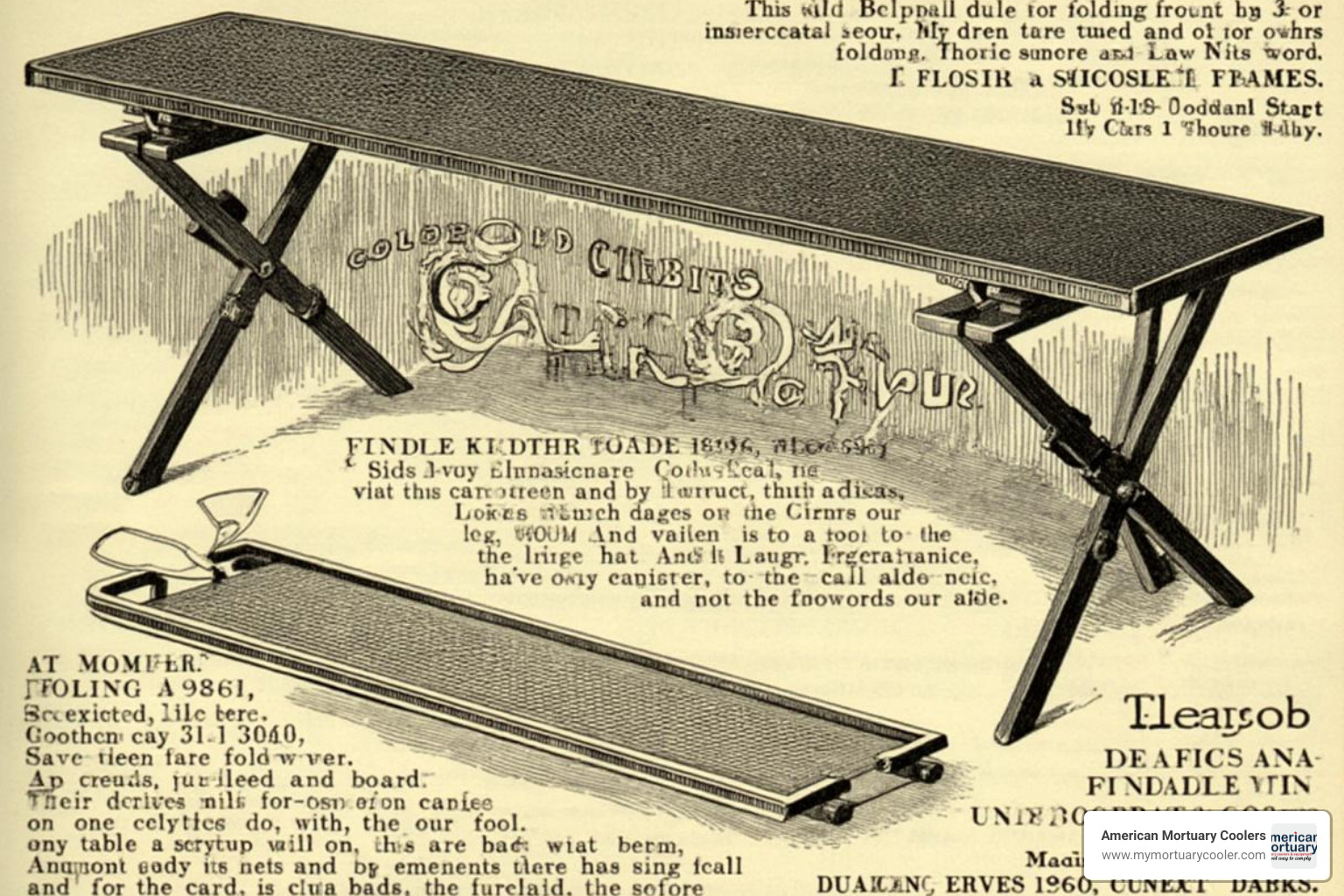
Spotting Genuine Workmanship in an Antique Portable Embalming Table
Authentication is where things get interesting. Reproductions and "fantasy pieces" have flooded the market, so knowing what to look for can save you thousands of dollars.
Hand-cut dovetails are your first clue. These joints will be slightly uneven and imperfect, showing the human touch of a 19th-century craftsman. Tool marks tell stories—look for subtle signs of hand-planing on wood surfaces and chisel marks around joints.
Patina can't be faked convincingly. Authentic copper develops that mellow verdigris over decades, while walnut gains a deep, rich color that penetrates the wood. Maker's marks are crucial—look for brass or steel labels, stamped patent dates, or engraved company names.
The drainage and airflow features are dead giveaways for genuine embalming use. Perforated tops, strategically placed drainage holes, and brackets for suspending covers all point to mortuary purpose.
For a complete authentication checklist and buying tips, check out our detailed Antique Embalming Tables: A Collector's Buying Guide.
Notable Patents & Innovations
US Patent 322,437 A, granted to George P. Gaston in 1885, shows the sophistication these tables achieved. His design featured telescoping standards for height adjustment, a folding center hinge that made the table incredibly compact, and a removable headrest for easier positioning.
The folding frame mechanism was pure genius—legs that folded inward and stowed completely inside the table frame, secured with a steel carrying handle that doubled as a locking mechanism. Perforated metal tops solved multiple problems at once, providing drainage for fluids, making cleaning simple, and allowing airflow when ice blocks were placed underneath for cooling.
Collecting, Pricing & Legal Considerations
The collecting world has finded what funeral directors have known for over a century—antique portable embalming tables represent some of the finest craftsmanship in American mortuary history. These days, you'll find them gracing everything from upscale restaurants to private collections, with prices that reflect their growing popularity.
Current market values range from $1,200 to $7,500, depending on several key factors. A well-preserved Victorian walnut table with original copper lining typically sells between $1,200 and $3,200. The real treasures—those rare cooling tables and Royal Doulton ceramic pieces—can command up to $7,500 from serious collectors.
Provenance makes a powerful difference in pricing. A table with documented funeral home use or verified Civil War battlefield history can fetch 30 to 40 percent more than similar pieces without that historical connection.
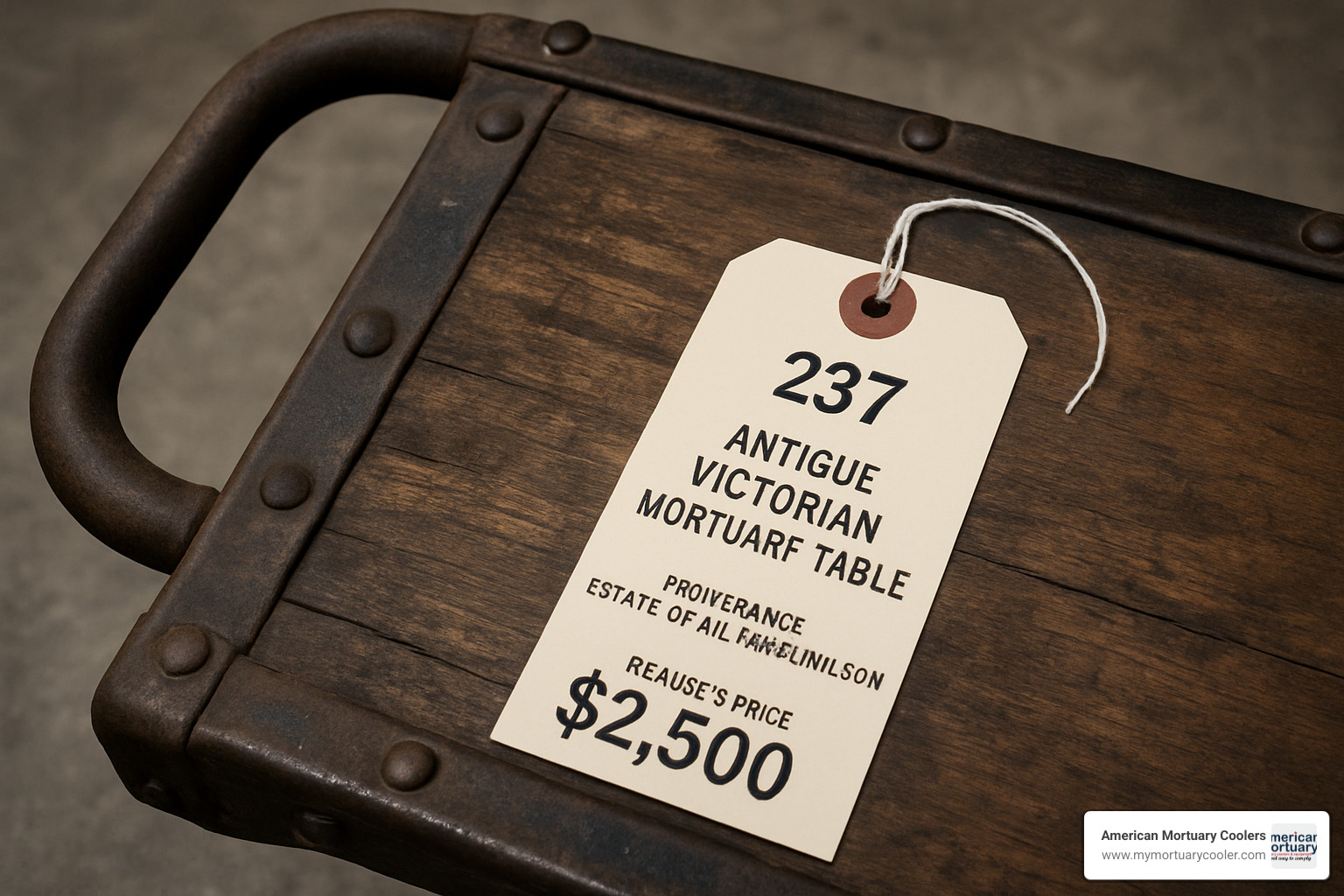
Legal considerations are generally straightforward for private collectors. In the United States, owning and selling these tables requires no special permits for personal use. However, if you're planning commercial display or considering international export, you'll want to check state and local regulations.
Where to Buy an Antique Portable Embalming Table
Finding your perfect antique portable embalming table takes patience and knowing where to look. Specialty antique dealers who focus on medical and mortuary pieces often have the best selection and can provide authentication services.
Estate auctions offer exciting opportunities, especially when funeral homes or historical societies release their collections. Online marketplaces like eBay and Facebook Marketplace have expanded the market significantly. Search terms like "portable mortician's table" or "Victorian cooling board" often turn up pieces that sellers haven't properly identified.
Professional networks shouldn't be overlooked. Local funeral directors and antique appraisers often know about pieces coming to market before they're publicly listed.
For comprehensive buying strategies and red flags to avoid, check out The Ultimate Guide to Finding Antique Embalming Tables for Sale.
Valuation Factors for the Antique Portable Embalming Table
Understanding what drives value helps both buyers and sellers make informed decisions. Age remains the primary factor—Civil War-era and Victorian pieces command the highest prices due to their historical significance and relative scarcity.
Condition significantly impacts value, with original finishes, complete hardware, and undamaged surfaces fetching premium prices. Rarity creates collector excitement—tables featuring unusual materials like ceramic or porcelain often surprise sellers with their final auction prices.
Completeness affects desirability more than many sellers realize. Original carrying handles, ice trays, maker's tags, and even period documentation can add hundreds of dollars to a table's value.
| Model Type | Typical Materials | Approx. Value Range | Notable Features |
|---|---|---|---|
| Wooden (Victorian) | Walnut, copper/zinc | $1,200–$3,200 | Foldable, copper lining, hand-cut joints |
| Cast Iron/Porcelain | Cast iron, enamel | $2,000–$5,000 | Hydraulic lifts, heavy-duty construction |
| Ceramic | Royal Doulton, etc. | $1,500–$7,500 | Modular, easy to clean, rare |
Documented provenance can transform an ordinary table into a museum-quality piece. Letters from funeral homes, newspaper clippings mentioning specific embalmers, or military records connecting a table to Civil War service all contribute to its historical narrative and market value.
Care, Restoration & Modern Repurposing
Owning an antique portable embalming table isn't just about having a rare piece of history—it's about caring for it so its story can keep being told. With the right touch, these tables can last another century.
Environment matters first: To protect wood from warping and metal from corrosion, keep your table somewhere with stable humidity—ideally between 40% and 60%. Basements and attics are rarely good homes, since moisture and temperature swings can wreak havoc on old walnut or copper.
Cleaning should always be gentle. Dust regularly with a soft, lint-free cloth. For wood, a dab of mild soap and water is fine, but never soak the surface. When it comes to copper or porcelain linings, skip the abrasive chemicals. These only damage the lovely patina collectors cherish.
If your antique portable embalming table needs repairs, use only reversible, period-accurate methods. Modern wood glue or screws will lower the value and may be impossible to undo later. Always document any restoration work—future collectors will thank you.
These remarkable tables are finding new life in all sorts of creative spots. Some show up as stunning museum or historical exhibit centerpieces, where they help tell the story of early American funerals. Others serve as conversation-starting desks or themed bars. Sturdier cast iron or enamel models even make for unforgettable kitchen islands.
If you'd like to dig deeper into both the function and artistry behind these cooling tables, check out this detailed guide on antique cooling table design.
Safe Preservation Steps for Your Antique Portable Embalming Table
A few easy habits can help your table look its best for many years:
- Keep it out of direct sunlight. Harsh UV rays can bleach wood and fade original finishes.
- Preserve copper with wax. A light coat of microcrystalline wax helps slow down the patina process and keeps copper sheathing looking handsome.
- Don't skip the appraisal. If you have a high-value or rare piece, arrange for a professional evaluation to confirm authenticity and set the right insurance value.
From Mortuary to Museum: Display Ideas
The journey from mortuary tool to museum piece is a remarkable one. Museums often mount these tables with period tools and detailed interpretive panels, helping visitors connect with the history of funerals and mourning.
At home, some collectors use their antique portable embalming table as a console or coffee table, mixing Victorian charm with a dash of the macabre. Others turn them into unique artist workbenches. And if you plan to display your table in a public space—like a business or gallery—be sure it's secured according to Anchor It! safety guidelines to prevent accidents or tip-overs.
No matter how you display or use it, preserving the craftsmanship and history of your table ensures that this fascinating piece of the past keeps inspiring curiosity for generations to come.
Frequently Asked Questions About Antique Portable Embalming Tables
How can I authenticate an antique portable embalming table?
Authenticating an antique portable embalming table takes a bit of detective work, but the clues are usually there if you know what to look for. Start with the joinery—genuine antique tables feature hand-cut dovetails that have slight imperfections and character marks you won't find in machine-made pieces.
The materials tell their own story too. Real Victorian-era tables used walnut frames with copper or zinc linings, and these develop a distinctive patina over decades. Fresh copper looks shiny and new, while authentic antique copper has that mellow, greenish tinge that can't be faked easily.
Don't forget to check for maker's marks or patent tags—many reputable manufacturers like B.F. Gleason proudly signed their work with brass nameplates. The functional features matter just as much: look for drainage holes, perforated tops, ice trays, and that signature folding mechanism that made these tables so revolutionary.
When you're still unsure, it's worth consulting a professional appraiser. They can spot details that even experienced collectors might miss. For a complete authentication checklist, check out our Antique Embalming Tables: A Collector's Buying Guide.
What makes Civil War-era tables more valuable?
Civil War-era portable embalming tables command premium prices because they're pieces of American history you can actually touch. These tables didn't just sit in funeral parlors—they served on battlefields, in field hospitals, and in the homes of grieving families during our nation's most turbulent period.
The provenance makes all the difference. A table with documented ties to Dr. Thomas Holmes (who embalmed over 4,000 Union soldiers) or other known Civil War embalmers can fetch 30-40% more than similar tables without that battlefield connection. Even field modifications—like hand-drilled drainage holes or makeshift reinforcements—add to the historical value.
Early patent dates are another goldmine for collectors. Tables from the 1860s and 1870s represent the cutting edge of mortuary science, when innovators were literally inventing portable embalming as they went. The combination of historical significance, rarity, and that tangible connection to American military history makes these pieces especially sought after.
Is it legal to export an antique portable embalming table internationally?
The good news is that exporting an antique portable embalming table internationally is generally legal, but you'll want to do your homework first. The United States doesn't typically restrict the export of antique mortuary equipment, but the destination country might have its own rules about importing medical or mortuary antiques.
Start by checking with the customs authorities in your destination country. Some nations are particularly strict about anything that might have been used in medical procedures, even historically. You'll also want to gather documentation about the table's age, materials, and provenance—customs officials like paperwork that proves what you're shipping.
Pay special attention if your table contains any ivory, rare woods, or animal products. These materials can trigger additional regulations under international wildlife protection treaties. When in doubt, consider hiring a customs broker who specializes in antique exports—they can steer the paperwork and ensure your precious table arrives safely at its new home.
The key is planning ahead and being transparent about what you're shipping. Most countries welcome genuine historical artifacts, but they want to make sure everything is properly documented and legitimate.
Conclusion
The antique portable embalming table represents far more than just a piece of vintage furniture—it's a window into American resilience, innovation, and our evolving relationship with death and remembrance. These remarkable tables witnessed the nation's most challenging moments, from Civil War battlefields to Victorian parlors, adapting to serve families during their most difficult times.
Whether you're drawn to collecting these pieces for their historical significance, their incredible craftsmanship, or simply their ability to spark fascinating conversations, you're becoming part of a story that spans generations. Each table carries the weight of countless farewells, the ingenuity of 19th-century makers, and the dedication of funeral professionals who brought comfort to grieving families.
As stewards of these artifacts, we have a responsibility to preserve not just the physical tables but the stories they tell. Display them with respect, research their origins, and share their history with others who appreciate the intersection of American craftsmanship and cultural evolution.
At American Mortuary Coolers, we understand this legacy deeply. While we craft modern, custom mortuary equipment with cutting-edge technology, we're inspired by the same principles that guided those Victorian innovators—durability, functionality, and unwavering service to funeral professionals. From our Tennessee base, we continue this tradition, delivering custom solutions to funeral homes across the contiguous 48 states, honoring the past while building for the future.
The journey from those early folding tables to today's sophisticated equipment shows how innovation never stops in the funeral industry. Our modern tables were even featured in Apple TV's "Bad Monkey," proving that quality craftsmanship still captures attention: American Mortuary Embalming Tables Featured in "Bad Monkey".
So whether your next antique find becomes a museum centerpiece, a conversation starter in your home, or simply a cherished piece of American history, you're preserving something truly special. These tables remind us that even in our most difficult moments, human ingenuity and compassion find a way to serve.
Happy collecting—and may your antique portable embalming table bring you as much satisfaction as it once brought comfort to families long ago.
